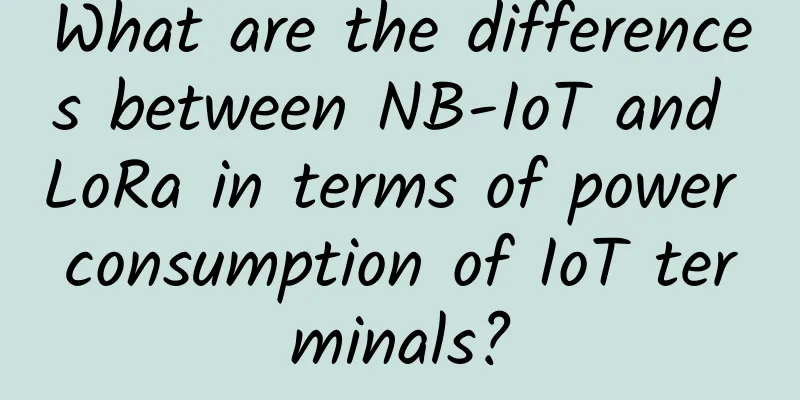What are the differences between NB-IoT and LoRa in terms of power consumption of IoT terminals?

|
To make a comparative analysis between NB-IOT and LoRa, we must first consider two important factors regarding the power consumption of IoT terminals, namely the current consumption of the node (peak current and average current) and the protocol content. The synchronous protocol of the cellular network requires that the terminal must be connected to the network regularly with a short downlink delay. LoRaWAN uses the asynchronous ALOHA protocol, which requires the terminal to be woken up regularly. The terminal can sleep for a longer or shorter period of time according to the specific application scenario requirements. The design concept of cellular networks is to improve the utilization of spectrum, which sacrifices node cost and battery life accordingly. In order to reduce costs and extend battery life, LoRaWAN nodes will have certain shortcomings in spectrum utilization. The essential requirement of terminal node operation is network coverage. For NB-IoT, an obvious advantage is that it can provide network deployment by upgrading existing network facilities. A prominent advantage of the LoRa industry chain is that members of each link have autonomy and can decide the scope of network deployment by themselves.
Anyone can install, operate and maintain a LoRa network. To support roaming or mobility, LoRa needs to sign different contracts with different network operators. In addition, different operators have different QoS issues. LoRa's vitality lies in its openness, but its flaws also lie in its openness. The fragmentation of the network itself will inevitably lead to the inoperability of mobility services. Security issues are gradually being put on the LoRa agenda. LoRa also needs to integrate additional security solutions to achieve the security of the Internet of Things. At this point, the technology based on the operator network has a natural advantage, that is, it has excellent security without the need for additional integration. It is difficult to tell which one of NB-IoT and LoRa has an absolute advantage in technology. The biggest difference between the two is whether they work in licensed spectrum. Due to interference and other problems, products based on unlicensed spectrum will have problems in just a few days. Licensed and unlicensed spectrum have become the key to the future development of NB-IoT and LoRa technology. NB-IoT and LoRa will shine in the fields of operator-level and enterprise-level LPWAN respectively. There is a healthy competitive cooperation relationship between the two. The licensed spectrum represented by NB-IoT and the unlicensed spectrum represented by LoRa will start from their respective advantages and carry out commercial use in a complementary manner. |
<<: Should I turn off my router when I go to bed at night? This is a question
>>: Deep Love News: The Data Center of the Future
Recommend
Juniper Networks continues to innovate and breaks down four barriers to embrace the era of digital convergence
[51CTO.com original article] The 2017 Juniper Net...
Are enterprises ready for open RAN?
The increasing deployment of 5G has brought about...
Seven chatbot building platforms: Easily build your own bot
【51CTO.com Quick Translation】 Chatterbot is a pro...
An article to show you how to use Nginx as a proxy for WebSocket
Hello everyone, I am Xiao Jiang. The previous art...
5 tips for hosting a successful virtual meeting
Running a virtual meeting requires a very differe...
It’s time to understand HTTPS and the encryption behind it
HTTPS (Hypertext Transfer Protocol Secure) is an ...
ProfitServer: 40% off on Russian dedicated servers, starting at $28.29 per month for unlimited traffic
The first time to share information about ProfitS...
"Ruisu API Security Governance Solution" won the double award of "Xinzhi Award"!
Recently, the "Xinzhi Award·4th Excellent Fi...
Let's talk about UPNP and DLNA protocols
Preface There is no love, only technology. Let me...
Sharktech: 1Gbps unlimited traffic from $79/month, 10Gbps unlimited traffic from $329/month, data centers in Los Angeles/Denver/Netherlands
Sharktech (also known as Shark Data Center, SK Da...
HTTPS learning summary
Preface I've been reading about HTTP recently...
[Understand Routing in Seconds] Now that we have an IP address, is a MAC address still necessary?
I wonder if you are confused: Why do we need a MA...
Ministry of Industry and Information Technology: Cancellation of data "roaming" fees will be implemented as scheduled in 2018
The State Council executive meeting on April 4 cl...
Talk: Application is slowed down? The culprit is Log4j!
[[338229]] Some time ago, we discovered that a Sa...









